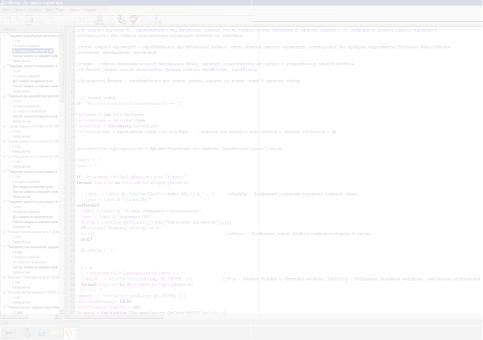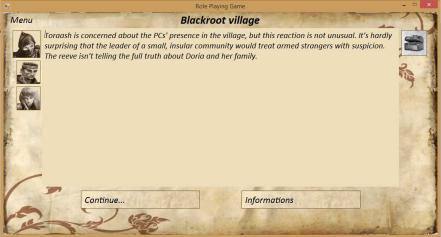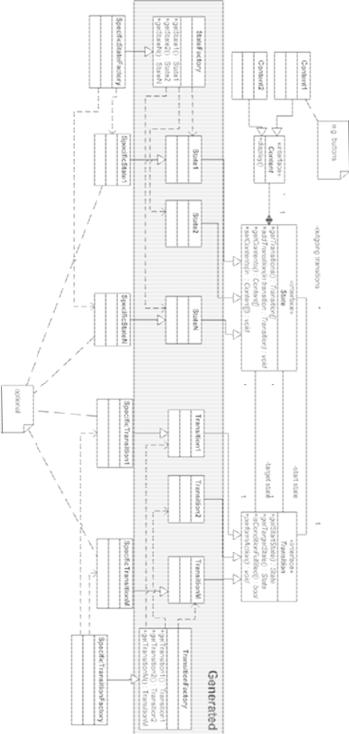
Proceedings of 6th International Conference of Young Scientisis on Solutions of Applied Problems in Control and Communications
..pdf
Example of the realized standard route (given in figure 2, the initial stage is sorted in more detail) it is possible to divide into 3 parts.
Fig. 2. Algorithm of a standard route of business process in accordance with specifications, technical requirements (the initial stage is sorted in more detail)
The first part is a coordination in the enterprise (the unit manager, 3 groups coordinating). Coordination at each stage happens in parallel, that is all participants of group coordinating the first (second or third) stage receive a task at the same time, this approach considerably accelerates process of coordination of the document. Stages of coordination are located consistently, the system passes to the following stage, only if the previous is executed completely. Otherwise, if though on one of stages the document isn't agreed, it is sent back for revision to the initiator. After check and completion the document repeatedly comes back to the interrupted stage. In case of impossibility of correction or completion of the document, the initiator can stop works on the document, previously having coordinated this step with the head. The head having coordinated termination of
41

work according to the document, can stop completely a route and work with the document, and can send the document along a route anew.
The second part is a coordination with external structures outside the enterprise. In this case, the document go es with the cover letter.
The third part – a stage will be con tinued only after performance of the first of two. At this stage, mailing of the document to a certain circle of people for acquaintance or further work with this document is carried out.
Each block of a standard route can be programmed in the «IS Builder language». It is specially built-in lang uage on environment executions of «IS-BUILDER».
«ISBL» is the interpreted program ming language, which is built in the «IS-BUILDER» platform high-level in which all program calculations in the systems developed on this platform are set. He allows to create necessary conditions of performance of tasks, it is correct to control process of performance of tasks, to exclude mista kes of people in the course of work, to process data and parameters.
In the course of realization of a sta ndard route some blocks, the main objectives of algorithms, in these blocks were programmed, consist in verification of necessary electronic keys at users, and correctness of filling of control cards of documents and reports.
Fig. 3. The window code editor IS -BUILDER language (ISBL)
42
5. Results
Result of introduction of this decision on automation process business, we received:
∙Reduction of time of carrying out process business: earlier the document was necessary to coordinate and claim 1-2 weeks, now it can be done in 1-3 days;
∙Labor input of processes is significantly reduced;
∙Complete control is received it was necessary carrying out process business, that is it is possible to receive actual information on performance of this or that stage of process, to reveal the problem places detaining its execution;
∙The risk of loss of documents is almost completely excluded, it is provided with reliability of an electronic database, duplication of documents, protection against casual removal or change, system of groups of the admission to editing documents.
Conclusions
Systems of electronic document flow allow to operate information streams and documents effectively.
First, the speed of transfer and information processing significantly increases.
Secondly, the space necessary for storage of documentation is considerably reduced.
Thirdly, use of systems allows to gain notable economic effect.
In summary it is possible to tell that systems electronic systems on automation of information become an integral part of the modern enterprises and firms.
References
1.Management of business processes and information of the enterprise. Definitions of classes of systems and transfer of their functionality. – URL: http://www.directum.ru/5686299.aspx. – 2011.
2.About DIRECTUM system. – URL: http://www.directu m.ru/ system. – 2011.
3[Electronic document flow (ECM systems)]. – URL: http://ecmjournal.ru/mustknow
43
АВТОМАТИЗАЦИЯ БИЗНЕС-ПРОЦЕССОВ ПО СОГЛАСОВАНИЮ ТЕХНИЧЕСКИХ ЗАДАНИЙ И ТЕХНИЧЕСКИХ ТРЕБОВАНИЙ
В СРЕДЕ ЭЛЕКТРОННОГО ДОКУМЕНТООБОРОТА
Роман ПОГОРАЗДОВ1, Николай ХОРОШЕВ2
Пермский национальный исследовательский политехнический университет, Пермь, Россия
(1e-mail: rom_pog@mail.ru, 2e-mail: horoshevni@mail.ru)
Аннотация. В данной статье рассматривается пример автоматизации бизнес-процесса по согласованию технических заданий и технических требований в корпоративной среде электронного документооборота «DIRECTUM» на крупном промышленном предприятии.
Ключевые слова: документооборот, типовой маршрут, бизнеспроцесс, технические требования, технические задания, система электронного документооборота.
44
COMPUTER-AIDED SOFTWARE DEVELOPMENT BASED
ON STATES MACHINES FOR RPG
Maroš POLÁK
Slovak University of Technology in Bratislava, Faculty of Materials Science
and Technology in Trnava, Slovakia
(e-mail: maros.polak.sk@gmail.com)
Abstract. The article deals with the field of the finite-state machine in developed computer game, genre role-playing game. The main objective of the thesis is to design and implement structure of finite-state machine into roleplaying game application, for design and controlling objects of locations and their connections. Next objective is implement code generator based on design structure of finite-state machine for generate source code of states and transitions into project of game application.
Keywords: states machine, computer-aided, source code generation, roleplaying game
Introduction
This article follows up on my bachelor thesis: Fuzzy-based Decision Making in RPG [1] about developing computer game. The developed computer game is role-playing game genre (RPG). The player assumes the roles of main character, which he created to his liking. Next player proceeds interactive story in fantasy environment. As the player character adventure and gain experience, character advance in level, find up new items and equipments. Character becomes stronger and he being capable to overcome various challenges and combat situations. Interactive elements accompany the player throughout the whole game. Player chooses own way of story. Story depends on the decisions of the player in key situations. The primary element of games is adventures. Adventures consist of several different locations with interactive features and they are connected with other locations. Locations can be divided into the following categories:
∙Place: Room or open space, which provides various options like move to other locations, begin conversation, trade or combat, interact with characters inventory or equipment contained in the location.
∙Conversation: when you talking to other characters, location provides to the user various options of questions, answers or actions which may result to additional conservations opportunities, changing the overall impression of your character or the reputation.
∙Map: location show to the user a certain area with opportunities of transport between different locations of the area.
45
∙Trade: Here the player can buy, sell or steal equipment.
∙Combat: player and his party are in combat, and may be using the combat actions and abilities to move on the battlefield, fight with enemies and use options of interaction with location.
In addition to these examples of basic options of locations, each location can contain its own unique possibilities of actions, which that may have an impact on other locations.
When I was developing applications games, I found the problems associated with the design and implementation of these game locations. Classical development methods were inadequate for the complex designs varied objects of locations and their connections. After discussions with my consultant Ing. Michal Sroka, I decided the best way to solve the problem is design final-state machine, which will be responsible for controlling the objects of locations and their connections, and design source code based on design structure of state machine, for effective design and implementation of these objects.
Objectives
According to the previous section, objectives related to role-playing game application and source code generator can be summarized as follows:
∙Design structure of software application which implement finitestate machine.
∙Implement role-playing game application with design structure of the state machine.
∙Design and implement simple source code generator based on design structure finite-state machine in role-playing game application.
Design structure of state machine and generator
The purpose of this chapter is to analyze the design of the structure fi- nite-state machine and source code generator.
Finite-state machine
A finite state machine (FMS) is conceived an abstract machine that can exist in one of finite different and predefined states. FMS also can define a set of conditions that determine when the state should change. A machine is in only one state at a time. The state it is in at any given time is called the current state. The current state determines how the FMS behaves. The current state can be change to another state when initiated by a triggering event or condition. This is called a transition. A particular FMS is defined by a list of its states, and the triggering condition for each transition [2].
46

Although FMS have been around for a long time, they are still quite common and effective in today's games. The fact that they are relatively simply to understand, implement, and debug contributes to their often use in game development. In this chapter, we discuss the fundamentals of finite state machines and show you how to implement them [2].
FMS is well suited for my problems with design objects of locations, because states of machine can represent locations and transitions of machine can represent connections of locations. Game after character creation initiates FMS with default start state, which is usually prologue of the story. Current state display text data on graphical user interface (GUI), and display too some opportunities to interact with the player's inventory or location (for example, see fig. 1).
Fig. 1. Graphical user interface of game
State includes a list of transitions, connections on the other locations. Each of transitions contains its own conditions, which must be true to realize of transition. Some transitions may have a condition always automatically true. Conditions correspond to the actual game parameters of external adventure and story events. All transitions that their condition is true will be displayed on GUI in due form, usually in the form of buttons. The button can be disabled to the user when the transition has already been executed once and transition not be reused or if the final state of transition is disabled due to external adventure and story events. The user selects a button determines which transition is to be executed. Entered transition is performed by its unique action. The executed action may provide information of the situation to GUI. Next FMS set the final state of transition as the current state and update GUI.
47

Fig. 2. Structure of the finite-state machine
48

Locations and their conections have certain features in common, by which they can be categorized and is important to use inheritance and polymorphism in state machine (Fig. 2). FMS provide options for creating new state or transition inherit attributes and methods from existing conditions and transitions. Some designed states and transitions may be abstract.
Source code generator
Source code generator is adapted to the needs of the structure of FMS in role-playing game aplication. Import all configuration files with the extension *state and *trans from the user specified folder. Consequently, the following files will collect the necessary information to create the source code according to predefined templates for objects of states and transitions. Finally generated source files with the extension *cs exported to user specified folder. GUI display the message about successful exporting or error. The user can enter the desired directory for the import and export manually or can search to directory. Also, the user has the option to delete all *cs source files from the destination folder before exporting the new source files. Information about previous directory of importing and exporting folder is saved in an external file, to be able to display when user restart the application. One example of this interface you can see on the fig. 3.
Fig. 3. Graphical user interface of generator
Implementation
Role-playing game application and source code generator is implemented using object-oriented approach. The source code is developed using C#. This programming language I have chosen for several reasons:
49
−is easy and modern;
−supports object-oriented programming;
−automatic memory management;
−I have yet most experience and knowledge of the C# language. Applications were programmed in development environment Microsoft
Visual Studio 2013, ainly because of the good connections for the .NET Framework and a wide range of tools supporting development of application.
In Table are display functional requirements specifications for the design and implementation of role-playing game applications and source code generator.
Functional requirements specifications
ID |
Functional |
Additional informations |
Priority |
|
requirement |
||||
|
|
|
||
|
|
|
|
|
1 |
Functionality of |
Game have all relevant functions to be playable |
must |
|
game |
for the ordinary user |
|||
|
|
|||
|
|
|
|
|
2 |
Gema Mecha- |
Algorithm mechanisms based on role-playing |
must |
|
nisms |
game rules |
|||
|
|
|||
|
|
|
|
|
|
|
User receives information about the plot and the |
|
|
3 |
Graphic |
situation in the game using text and illustrations |
must |
|
interface |
via Windows Forms tools (textbox, label, |
|||
|
|
|||
|
|
picturebox etc.) |
|
|
|
|
|
|
|
4 |
Communication |
User enters his choice via Windows Forms tools |
must |
|
Interface |
(button, textbox, combobox etc.) |
|||
|
|
|||
|
|
|
|
|
|
|
Import displaying the text data from a text file |
|
|
5 |
Multilingualism |
provides the possibility of implementing a an- |
can |
|
|
|
other language in the game |
|
|
|
|
|
|
|
|
Import of ob- |
Import of objects, for example: weapons, armor, |
|
|
6 |
enemies etc., from files provides the possibility |
can |
||
jects |
||||
|
of extending and modifying games |
|
||
|
|
|
||
|
|
|
|
|
|
Implemented |
The structure of software applications which |
|
|
7 |
structure of |
implement a FSM is responsible for controlling |
must |
|
|
FSM |
the objects of locations and their connections. |
|
|
|
|
|
|
|
|
Import of states |
Import of states and transitions objects from con- |
|
|
8 |
and transitions |
must |
||
figures files. |
||||
|
objects |
|
||
|
|
|
||
|
|
|
|
|
|
Automatic in- |
Automatic include generator created and export- |
|
|
9 |
clude of ex- |
can |
||
ed source files to the project of game |
||||
|
ported files |
|
||
|
|
|
||
|
|
|
|
|
|
Documentation |
Documentation is used to describe the source |
|
|
10 |
of source code |
must |
||
code algorithm of generator |
||||
|
generator |
|
||
|
|
|
||
|
|
|
|
50
